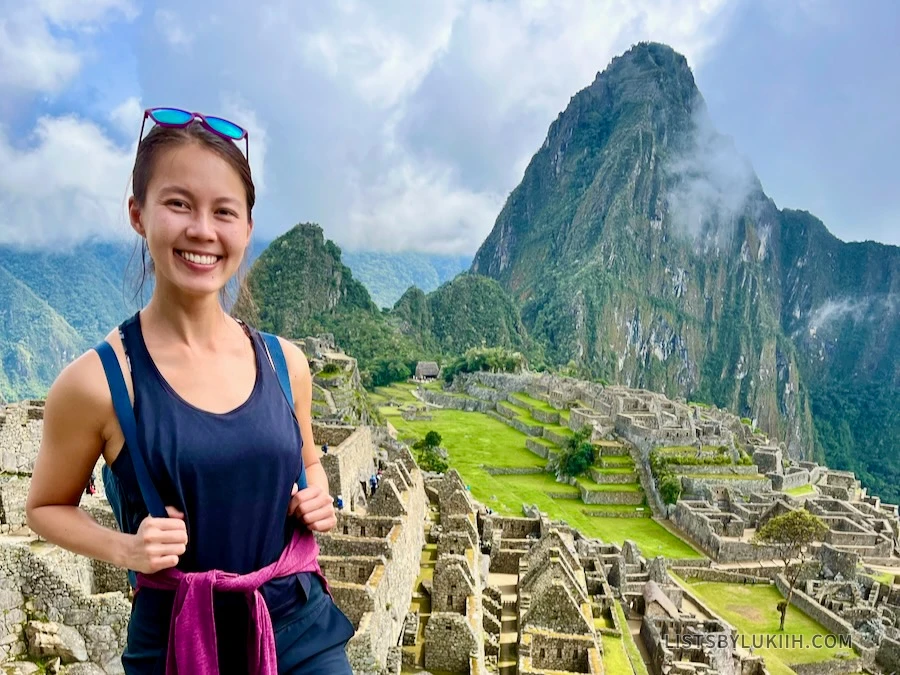Peru is one of the 20 biggest countries in the world and is home to one of the Seven Wonders of the World.
Ten days is enough time to visit the remarkable Machu Picchu, eat your way through Lima, and see other top natural attractions.
I spent an adventurous ten days in Peru, and here, I share amazing things to do and tips on optimizing your trip itinerary. This post covers:
- 🗓️ 10-day optimized itinerary
- ⭐️ Top attractions in the country
- 📍 Peru map with key places
- 💎 Firsthand travel tips
- 🏠 Where to stay
- ✏️ Peru trip planner
Planning a trip? Here’s what to know about Peru.
Lists By Lukiih is readers-supported. When you buy with my affiliate link, I may earn a small commission. Thanks!
Peru Itinerary Route
This itinerary takes you to some of Peru’s best places:
- Machu Picchu – one of the Seven Wonders of the World.
- Lima – the gastronomic capital of South America.
- Huacachina – the only desert oasis in South America.
- Sacred Valley – a lush and picturesque region.
- Rainbow Mountain – a natural wonder.
About This Peru Itinerary
This Peru itinerary efficiently sequences attractions and activities the country is famous for. It gives you the opportunity to:
- Hike the Inca Trail to reach Machu Picchu
- Sandboard down massive dunes in a beautiful desert
- Eat culinary delights in the metropolis of Lima
- Visit beautiful landscapes like Rainbow Mountain
- See Inca ruins, temples, and terraces
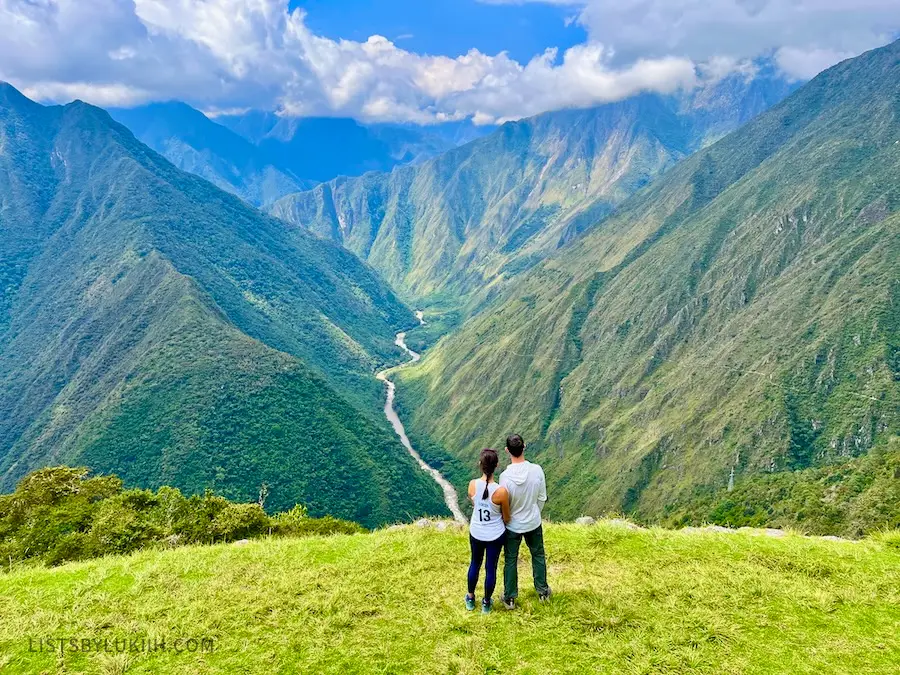
7 Essential Tips for Visiting Peru
Before getting into the itinerary, here are practical tips to know when traveling to Peru.
Most of these tips were provided by my childhood friend, Isabela, a Peru local of over a decade.
✊🏻 1. Check for civil unrest.
Unfortunately, civil unrest and protests are common in Peru. I visited Peru during two temporary strikes that significantly impacted my trip.
You can’t always predict or avoid protests but know they generally happen during Peruvian holidays. Strikes are frequently planned during busy travel times to give the group on strike more negotiation leverage.
💵 2. Withdraw soles.
Peru’s economy is primarily based on cash transactions, so bring a minimum of $50 worth of cash per day.
US dollars and Peruvian soles are widely accepted, but you may not get a favorable exchange rate if you use the former.
Learn more cash-related tips for Peru.
🚗 3. Be careful when crossing the streets.
Unlike in the United States, pedestrians do not have the right of way. There are no cultural norms to stop for pedestrians in Peru.
As my local friend said, “This is not New York City. Peruvians will run you over.” I learned from personal experience that stop signs are treated as suggestions.
💬 4. Download WhatsApp.
Like other countries in South America, most people and businesses in Peru use WhatsApp to communicate.
Download WhatsApp (iOS, Android) before traveling to Peru to communicate with small businesses, tour companies, restaurants, etc.
💰 5. Don’t excessively haggle.
Peruvians are generally kind people who will try to help you. But Peru is also one of the poorest countries in South America, so they will upcharge or rob tourists if the opportunity presents itself.
Haggling is expected, especially in tourist places like Cusco, but don’t overdo it. Since you’re traveling to Peru, your earning potential is likely much higher than the average Peruvian seller.
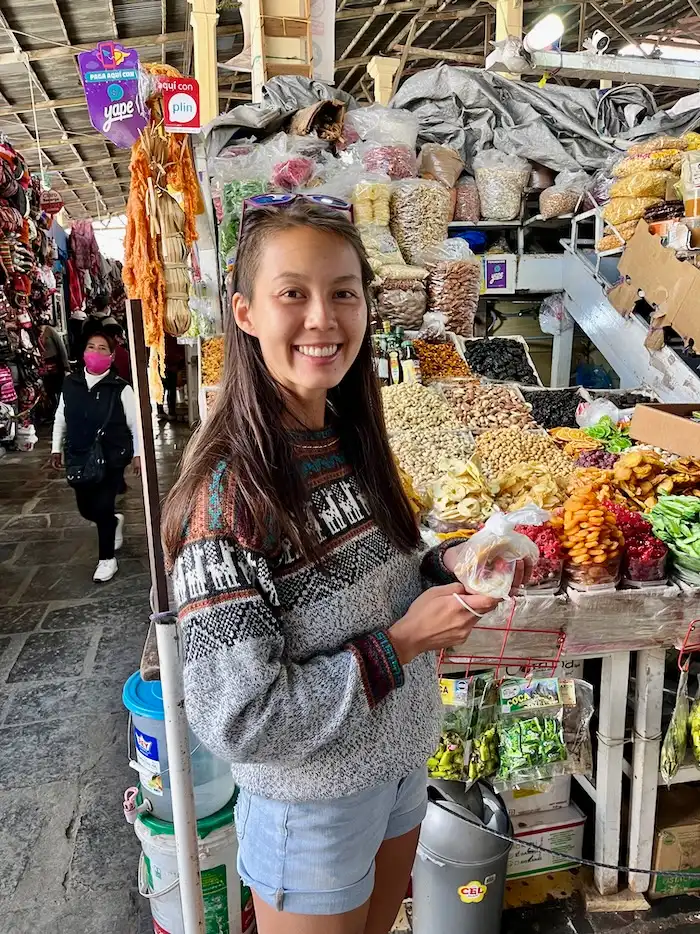
😣 6. Prepare for an upset stomach.
Peru’s food tends to be very well-seasoned and can use ingredients foreign to your body. It’s not rare to get an upset stomach or food poisoning (one of my travel companions got sick).
Don’t drink tap water and avoid raw vegetables in Peru.
If you have a sensitive stomach, avoid street foods and consider bringing Pepto Bismol tablets.
🦟 7. Bring insect repellent.
Peru has mosquitos, and some areas have high risks of diseases like dengue, Zika, malaria, and yellow fever. Mosquitos are especially prevalent in the Amazon Rainforest and rural areas of Peru.
Mosquitoes are also most prevalent during the rainy season, typically from November to March.
I’m a mosquito magnet, and while I didn’t see many mosquitoes in cities like Lima and Cusco, I did see them at the beginning of my Inca Trail hike. It’s a good idea to pack insect repellent.
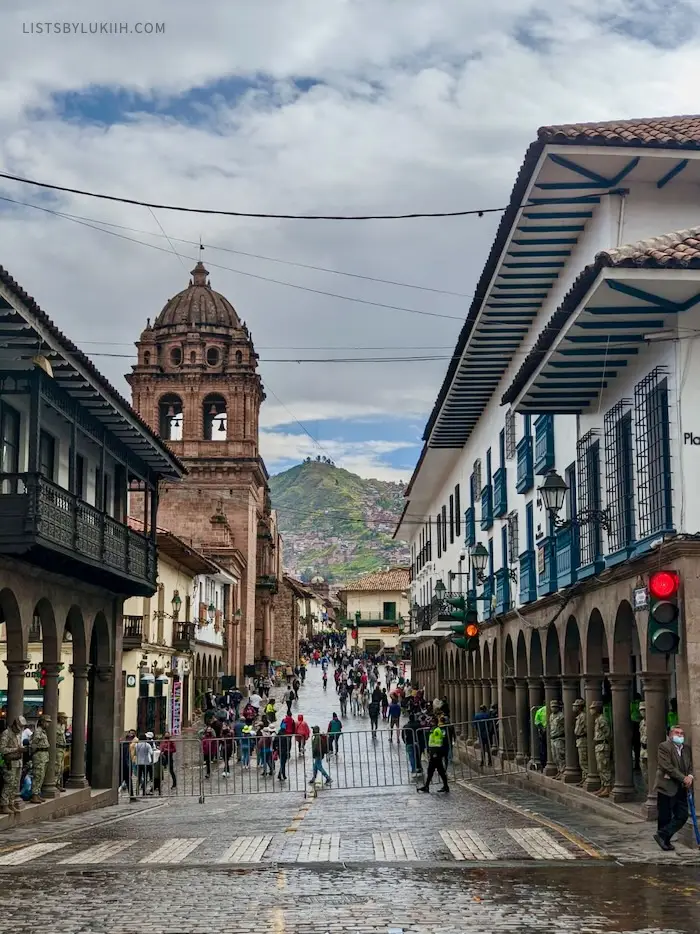
Learn other practical tips when traveling to Peru.
Peru Map
This map has all the recommended places in the Peru itinerary below.
10-Day Itinerary for Peru
Below is a great way to spend ten days in Peru.
The Peru trip planner has this itinerary prefilled with details.
| Day 1 | ⛰️ Explore Cusco |
| Day 2 | 🧣 Sacred Valley Day Trip |
| Days 3-5 | 🥾 Hike Inca Trail to Machu Picchu |
| Day 6 | ☀️ Explore Machu Picchu and Aguas Calientes |
| Day 7 | 🌈 Rainbow Mountain Day Trip |
| Day 8 | ✈️ Explore Lima |
| Day 9 | 🏂🏻 Huacachina Day Trip |
| Day 10 | ✈️ Depart from Lima |
All prices mentioned here are in USD 💵 .
Cusco (Days 1 & 7)
Fly into Cusco’s airport and start your Peru trip there.
🇵🇪 Why Visit Cusco?
Cusco, the former capital of the Inca Empire, is today the gateway city to Machu Picchu and two other top Peru attractions: Rainbow Mountain and the Sacred Valley.
Cusco’s proximity to several of Peru’s best attractions makes it an ideal starting point. It is itself a vibrant city with well-preserved Inca archaeological sites and local markets.
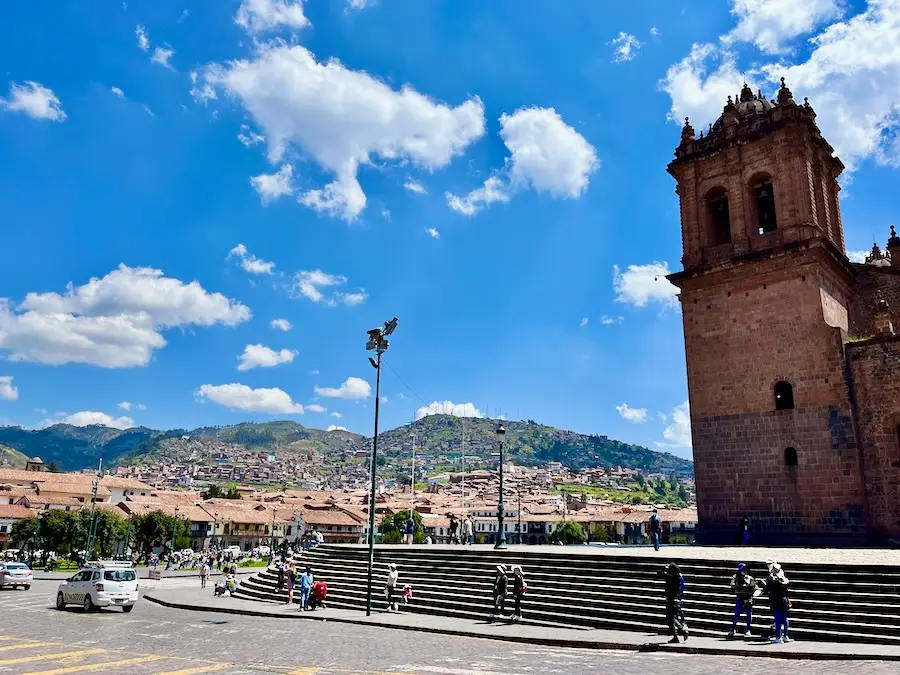
📍 Getting to Cusco
Cusco is located in the Peruvian Andes Mountains, a mountain range that cuts across seven countries.
The best way to get to Cusco is to fly to Alejandro Velasco Astete International Airport (CUZ). The short flight from Lima takes less than two hours and typically costs less than $100.
In comparison, a bus from Lima to Cusco takes over ten hours. It’s cheaper and has more scenery, but it’s nowhere near as efficient as flying.
🌟 Top Attractions in Cusco
The small city of Cusco features several main attractions, including:
- Plaza de Armas – the city’s main square and a UNESCO World Heritage Site
- San Pedro Market (Mercado Central de San Pedro) – a bustling market offering fresh produce and local crafts
When visiting a Peru market, consider trying a local fruit. Some of my favorite fruits are guanabana, cherimoya, and granadilla.
- Qorikancha – an Inca temple dedicated to the Sun God
Cusco is also known as a great place to try cuy, a Peruvian delicacy made of guinea pig. The city has historically raised guinea pigs, and eating them has environmental benefits.
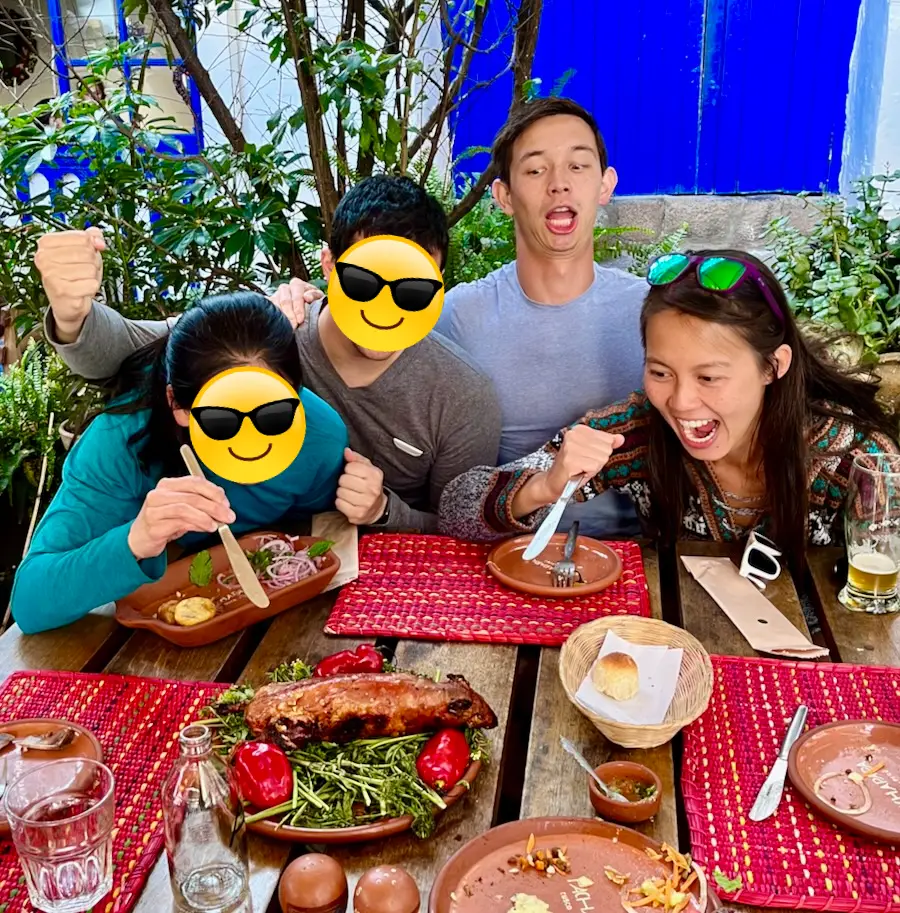
🏠 Where To Stay in Cusco
If this is your first time visiting Cusco, stay in or near the city center, Centro Histórico, which is within walking distance of many attractions.
For a luxury hotel, stay in Aranwa Cusco Hotel Boutique. They’re one of the few hotels that pump oxygen into the rooms to help combat altitude sickness. My travel companies stayed there and highly recommend them.
For a more mid-range option, I stayed near the Cooper Hotel Boutique. I found the location convenient and lively but not loud.
🍀 Lukiih’s Tips for Cusco
Cusco is a charming place to explore, buy souvenirs, and walk freely at night without being too concerned for safety. Here are my general tips for visiting this city:
- Take some time to get acclimated – Cusco is 11,000 feet above sea level. Spend your first night here getting used to the high altitude to combat altitude sickness.
Cusco is higher than Machu Picchu, so it’s an excellent place for hikers to acclimate.
- Spend half a day in Cusco – Cusco is primarily known as the gateway to Machu Picchu and other natural wonders, but the city itself is worth at least a half-day of your trip.
- Come prepared with cash – Cusco does not have a good Wi-Fi infrastructure, and I found that some ATMs were not well-stocked.
Sacred Valley (Day 2)
On your second day in Peru, head to the nearby Sacred Valley.
🇵🇪 Why Visit Sacred Valley?
Sacred Valley, called “Valle Sagrado” in Spanish, is a lush and picturesque region nestled between mountain ranges.
The area was culturally significant to the Inca civilization and features ruins, temples, terraces, and local markets.
Sacred Valley is 9,000 feet above sea level, so it should be easier to acclimate there than Cusco.

📍 Getting to Sacred Valley
Sacred Valley is an hour and a half north of Cusco. Most people get there via an organized Sacred Valley day trip that visits the various attractions in the large region.
Alternatively, you can get to Sacred Valley through a combination of train, taxi, and bus.
🌟 Top Attractions in Sacred Valley
The region of Sacred Valley is fairly vast and features several main attractions, including:
- Pisac archeological site – renowned for its Inca ruins
- Moray – an archeological site known for its unique circular agricultural terraces
- Salinas de Maras – a visually-fascinating salt pan
- Chinchero – a traditional village known for its textile production
- Ollantaytambo – a town and Inca site that hosts the famous Temple of the Sun
While many textile souvenirs in Cusco are mass-produced, those in Chinchero are authentic. Local artisans there employ generations-old weaving techniques.
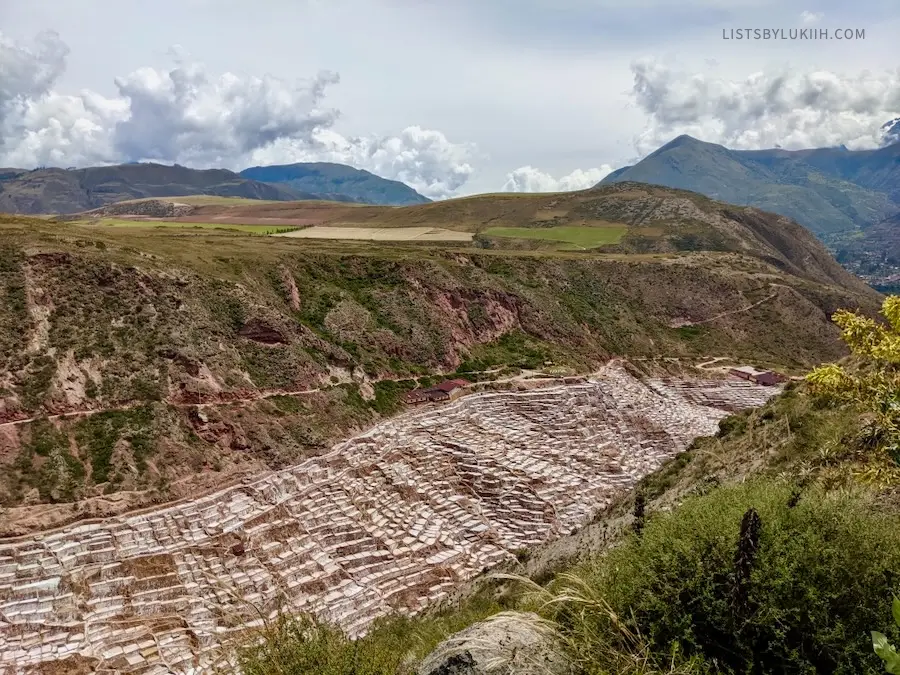
🍀 Lukiih’s Tips for Sacred Valley
I didn’t make it to Sacred Valley due to my Peru trip being disrupted by protests. My travel buddies made it, and these are their tips:
- One full day in Sacred Valley is sufficient – It’s a diverse and large region with much to offer. You can spend more than a day in Sacred Valley, but one day is long enough to see the main hits.
- Don’t buy souvenirs in Cusco – One of Sacred Valley’s highlights is the traditional textile production process in Chinchero. This is a great place to buy authentic souvenirs.
Machu Picchu (Days 3-6)
On your third day, you should be more acclimated to the high altitude and can visit one of Peru’s most famous places.
⛰️ Why Visit Machu Picchu?
Machu Picchu is Peru’s most famous archaeological site and one of the Seven Wonders of the World. It’s hard to call a Peru trip complete without it.
It’s the most significant Inca ruin that showcases the ancient civilization’s advanced engineering. The ruin’s backdrop of Huayna Picchu mountain is an iconic symbol of the country.
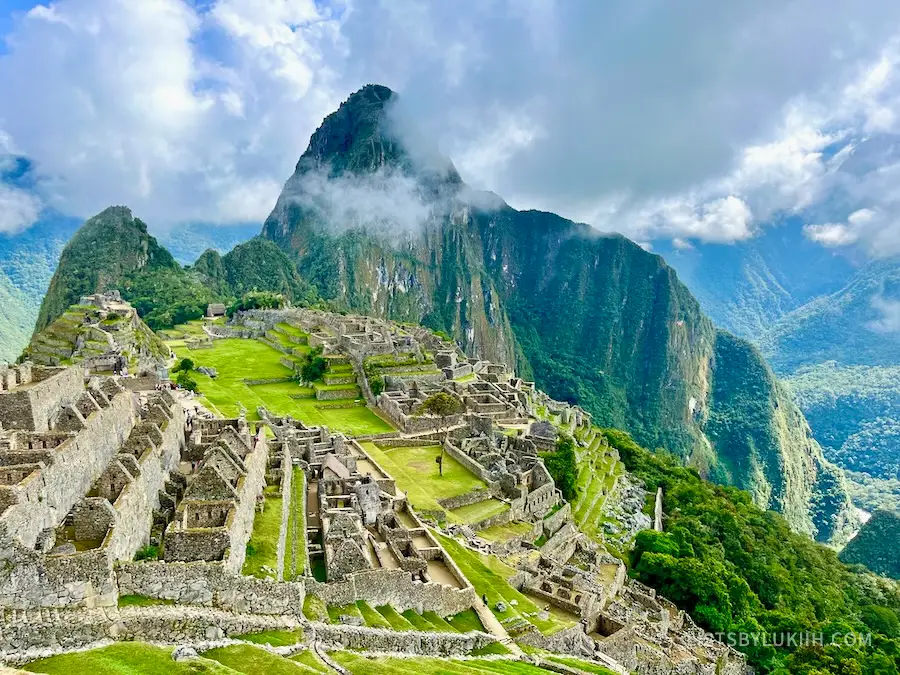
📍 Getting to Machu Picchu
To get to Machu Picchu, you need to start in Cusco. From Cusco, you can visit Machu Picchu in two ways:
🚌 Option 1: Train and Bus
The easiest way to get to Machu Picchu is to take a train from Cusco to Aguas Calientes and then a bus to the ruins.
A typical Machu Picchu tour takes about five hours if you get there by bus and train.
🥾 Option 2: Trekking
The more adventurous and breathtaking way is to hike the multi-day Inca Trail to Machu Picchu. The hike ends in Aguas Calientes, where you can catch the train back to Cusco.
Here’s how to hike the Inca Trail to Machu Picchu.
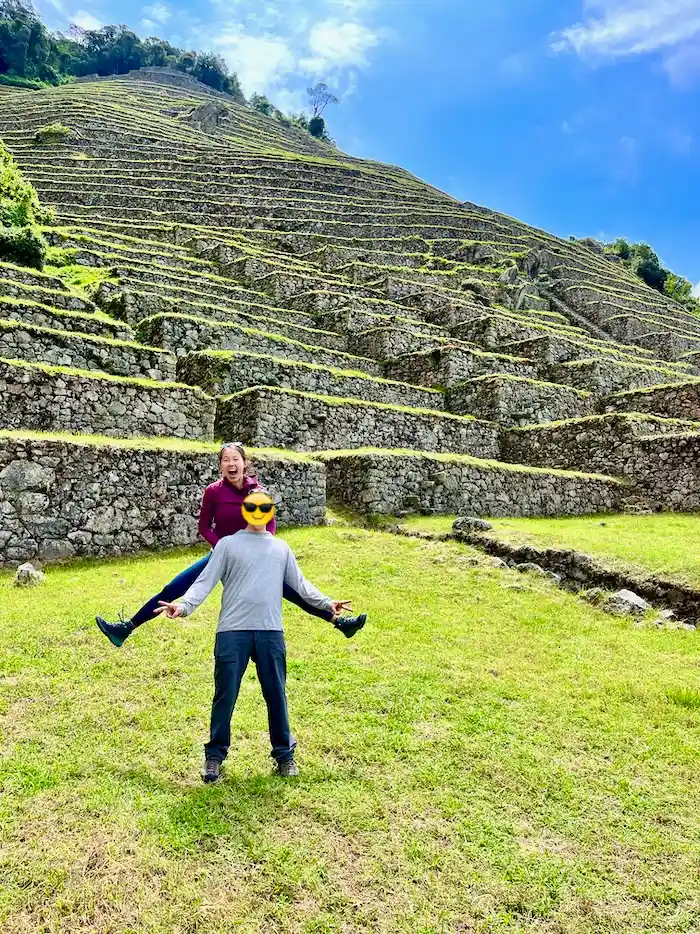
🍀 Lukiih’s Tips for Machu Picchu
I did the four-day Inca trail hike to the ruins of Machu Picchu, and it was the highlight of my Peru trip. It’s the most impressive ruin I’ve ever seen in South and Central America.
All of my Machu Picchu hiking tips are in this Inca Trail guide.
If you’re not planning on hiking, I recommend hiring a Machu Picchu tour guide. Having a knowledgeable guide walk significantly increased my appreciation for the Inca’s remarkable engineering.
Rainbow Mountain (Day 7)
After the hike to Machu Picchu, visit Rainbow Mountain or spend a rest day in Cusco.
🌈 Why Visit Rainbow Mountain?
Vinicunca, nicknamed “Rainbow Mountain, ” is a unique, multi-colored mountain whose vibrant colors come from mineral deposits.
It’s a beautiful destination for hikers, photographers, and those interested in interacting with some of the local Quechua-speaking locals.
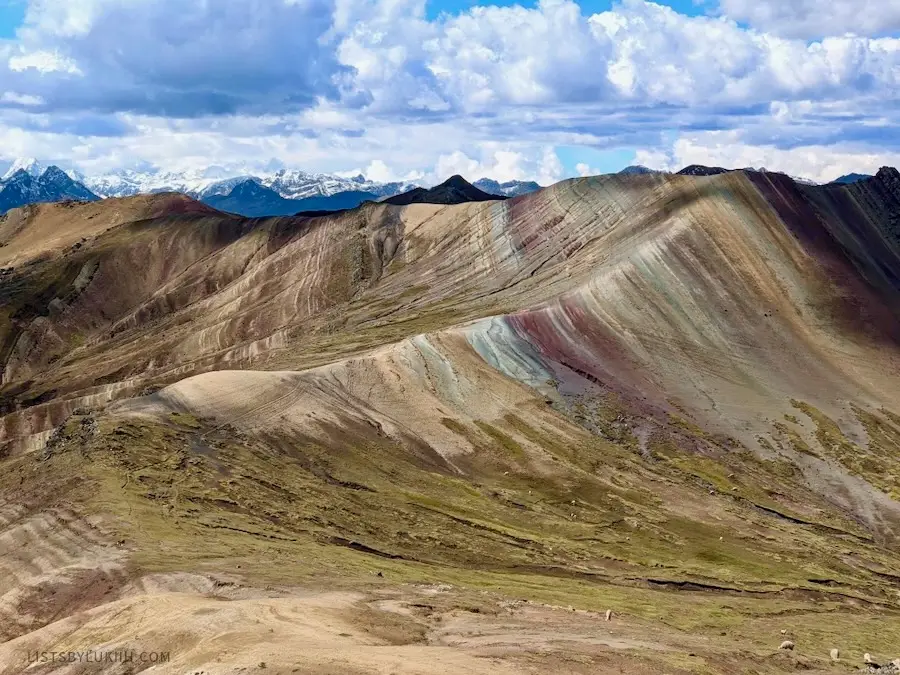
📍 Getting to Rainbow Mountain
Rainbow Mountain is a three-hour drive southeast of Cusco.
Visitors need to get there by vehicle, and the easiest way to do so is to book an organized tour that provides transportation. Otherwise, you’ll have to rent a car or travel by taxi and bus.
Here’s a five-star guided tour to the summit of Rainbow Mountain.
🍀 Lukiih’s Tips for Rainbow Mountain
Rainbow Mountain is a beautiful landscape that’s worth the trip.
- Get acclimated in Cusco first – Rainbow Mountain is located over 16,000 feet above sea level, so make sure you’ve had the chance to get used to the high altitude in Cusco first.
- Be mentally prepared – The mountain is most often visited as a full-day trip from Cusco, but it’s pretty far, so make sure you have the time and energy for it.
Avid hikers can camp overnight near Rainbow Mountain and hike for over ten hours. This is why the mountain is sometimes considered an alternative to hiking to Machu Picchu.
Lima (Day 8)
After a week in the Cusco region, take a short flight to Lima to see the coastal side of Peru.
🦐 Why Visit Lima?
The capital city of Lima is Peru’s largest and most metropolitan city, acting as the country’s economic hub.
Lima is particularly known for its culinary scene and is considered the gastronomical capital of South America.
📍 Getting to Lima
Lima is home to Peru’s main international airport, Jorge Chavez International Airport (LIM), so most foreign visitors fly into Lima. For this itinerary, fly into Lima from Cusco, which is a short hour-and-a-half flight.
The best way to get around Lima is by taxi or Uber.
Lima’s traffic is notoriously bad. Even if you see districts located right next to each other on the map, it might take longer to travel than you think, so budget extra time for transport.
🥩 What To Eat in Lima
The culinary experience in Lima ranges from delicious, local food to relatively affordable upscale dining experiences.
Traditional Peruvian food that my local friend recommends trying include:
- Lomo saltado – a stir-fry with sirloin steak. You can get these in many traditional Lima restaurants, including the affordable restaurant chain Tanta, founded by a famous Peruvian chef.
- Anticuchos – beef heart skewers. This is a must-try, and you can find many good places that serve them in Lima.

- Ceviches – usually made of raw fish and shrimp marinated in citrus. Seafood is common in Peruvian cuisine, and many local restaurants in Lima, particularly ones in Miraflores, serve them well.
Peru’s most famous alcoholic drink is the pisco sour. This refreshing drink consists of lime juice, pisco, egg whites, and sugar.
Some great upscale restaurants to try in Lima include the following:
- Maido – a famous Nikkei restaurant that requires about two months of advanced reservations. Since I couldn’t get a reservation at Maido, I ate at Osaka instead, and it was divine.
- Central – one of the most popular upscale restaurants in Barranco that serves traditional Peruvian food.
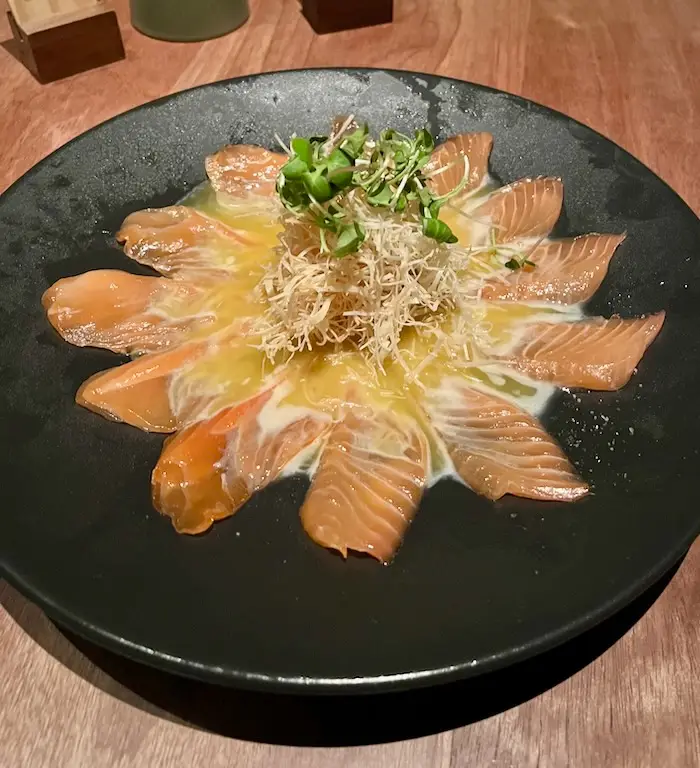
One way to sample Peruvian food is through a highly-rated Lima food tour.
🌟 Great Things To Do in Lima
If you have one to two days in Lima, my local friend and I recommend the following:
- Walk around Miraflores and Barranco – Miraflores is a beachfront district with parks, shops, and gardens. Barranco is an artistic, upscale district that’s pretty at night. The latter also has paragliding.
- Go to Museo Larco or Centro Histórico – Museo Larco is a beautiful art museum with a cafe and garden. Centro Histórico is a crowded city center surrounded by museums, food, and architecture.
Museo Larco and Centro Histórico are popular destinations, but they are far enough apart that you likely cannot visit both if you are in Lima for less than two days.
- Visit Chinatown (maybe) – Lima’s Chinatown, unlike many in the United States, doesn’t have Chinese residents, so walking around it can be a unique experience.
My local friend warns that Lima’s Chinatown is an impoverished area that many locals tend to avoid, so watch out for pickpockets and petty theft.
🏠 Where To Stay in Lima
For this itinerary, I recommend staying in the Miraflores District. Miraflores is one of the nicer neighborhoods in the capital. It has walking access to a few places and is not prohibitively far from the airport.
I stayed near Tierra Viva Miraflores Centro, located near Kennedy Park. I could walk to Lima’s coastal park within 15 minutes and felt safe at night.
🍀 Lukiih’s Tips for Lima
My local friend took me around Lima, and here are some of our tips on visiting the capital city:
- Spend only a day in Lima – You can spend anywhere from one to three days here, but I recommend prioritizing other places that make Peru truly unique. Lima can feel like another big city.
- Prioritize good food – One of the best things you can do in Lima is eat at various places and try different cuisines.
- Avoid dangerous areas in Lima – Lima has affluent and poor districts like many big cities. I enjoyed walking around Miraflores both during the day and at night, as it felt safe. However, do your research and avoid dangerous areas of Lima.
Huacachina (Day 9)
On your second day on the coastal side of Peru, head south to a special place.
☀️ Why Visit Huacachina?
Huacachina is the only desert oasis in South America. A trip there can feel surreal, as you’ll see massive sand dunes surrounding a small village with a natural lake.

📍 Getting to Huacachina
Huacachina is about a five-hour drive south of Lima. The nearby town of Ica does not have an airport, so you need to get to Huacachina by vehicle.
The easiest way to get to Huacachina is through an organized tour, which typically also stops at the mysterious Nazca Lines and interesting Ballestas Islands.
You can also hire a private taxi, take the public bus, or book a rental car.
See details on how to get to Huacachina.
🌟 Top Activities in Huacachina
The small village of Huacachina is primarily known for its scenic desert landscapes, so the top activities there are sandboarding, sand skiing, and dune buggy riding.
Thanks to its large sand dunes, Huacachina is known as one of the best places to sandboard in the world.
🍀 Lukiih’s Tips for Huacachina
Huacachina was one of my favorite places in Peru. The giant sand dunes were unlike anything I’ve ever seen before. Sandboarding and dune buggy riding were also thrillingly fun, and the sunset was stunning.
All of my tips for this unique place are in this Huacachina guide.
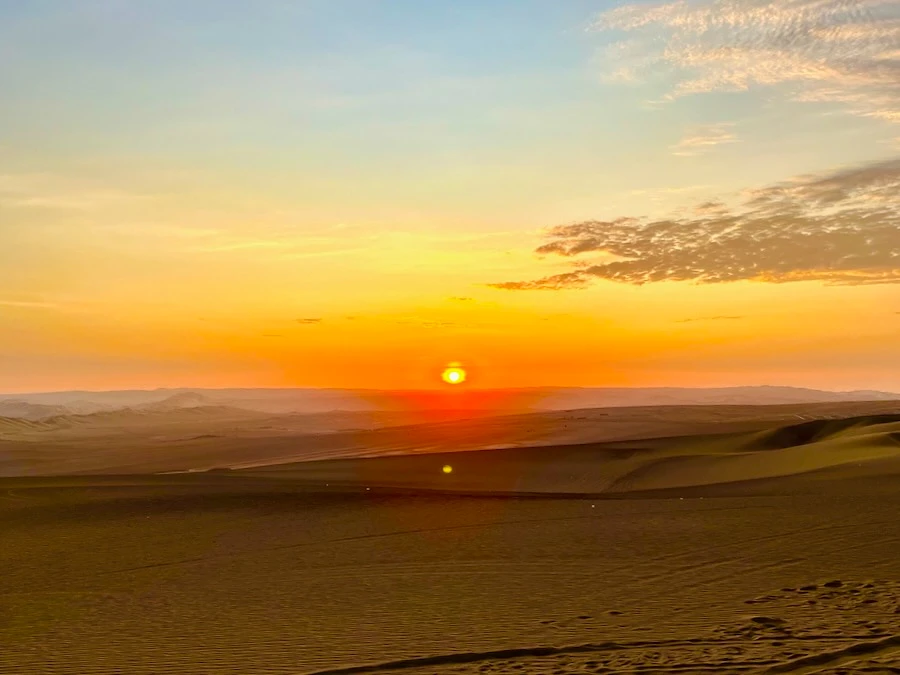
Depart From Lima (Day 10)
After your full day in Huacachina, head back to Lima. If you have time, eat at another great restaurant and explore one more district.
Remember to budget travel time to Lima’s airport with the city’s heavy traffic.
How much will a trip set you back? I share my travel expenses in this Peru budget breakdown.
With More Time: 2 Weeks in Peru
Peru is one of the 20 largest countries in the world, so there will be plenty to do if you stay longer than ten days.
If you want to visit more areas in Peru’s northern and southern regions, you’ll need two to three weeks in Peru.
With more time in Peru, you can visit other top attractions like:
- Lake Titicaca – This is South America’s largest lake, known for its stunning natural beauty. Visitors can hike, take a boat to the floating Uros Islands, and attend festivals.
- Arequipa and Colca Canyon – The canyon is another natural wonder known for its breathtaking panoramic views. It’s popular for hiking, bird-watching, and visiting hot springs.
- Puerto Maldonado – This city in southern Peru is the gateway to the Amazon rainforest and one of the most biodiverse regions in the world. Visitors can go on multi-day jungle trek tours to see exotic wildlife and plants.
Peru Trip Planner 2024
To make your travel preparation easier, download the trip planner below. It has destination-specific travel information, itinerary, map, and packing list.
My trip planners are built on Notion, which I use for all my travel planning. I genuinely love this tool and creating an account is free.
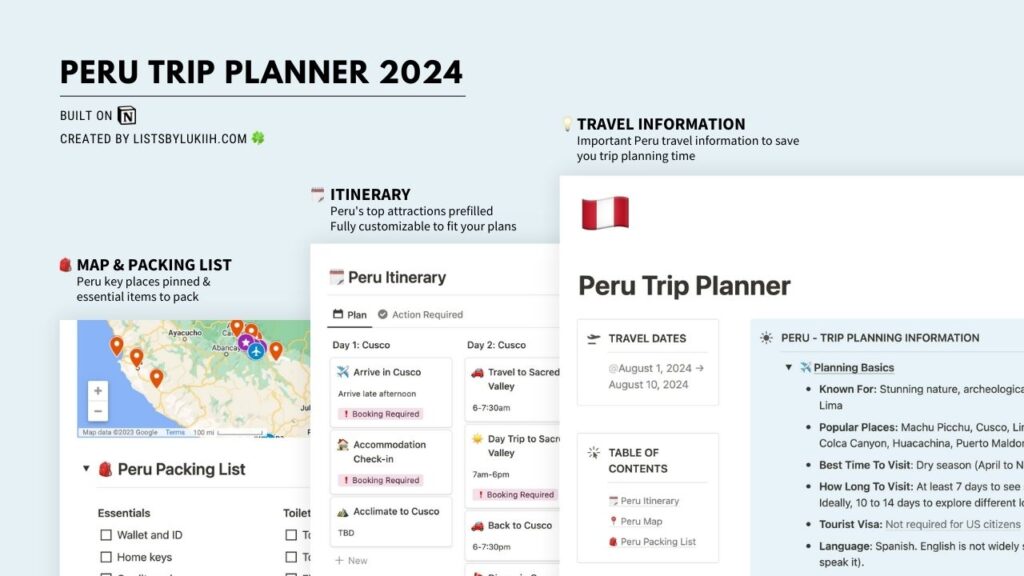
🧋 Support Lukiih
Lists by Lukiih is a humble website that I fund with my own savings. If you find my tips helpful, I appreciate you saying thanks with a bubble tea!
